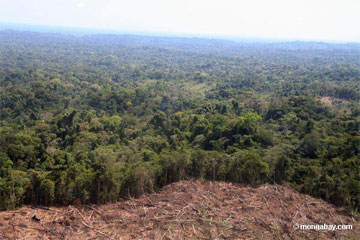Largest seizure of illegally logged Amazon rainforest timber announced by authorities
Largest seizure of illegally logged Amazon rainforest timber announced by authorities
mongabay.com
October 23, 2006
IBAMA, Brazil’s environmental agency, announced the largest seizure ever of illegally logged timber from the Amazon rainforest.
During a week-long operation — code named Kojima — in late September, authorities impounded nearly 15,000 cubic meters of unlicensed wood in the Amazonian state of Para. The agency said it was probably the largest seizure ever in the state. Para was the state where last year Sister Dorothy Stang, an American nun who worked with rural poor, was killed by gunman associated with local plantation owners. In response to the murder, the Brazilian government sent in the army to quell violence in the region and promised to step up environmental monitoring efforts.
 Amazon deforestation. Photo by R. Butler
|
The Kojima Operation follows the three-week Guariba Operation which confiscated 8,500 cubic meters of sawnwood and logs in the state of Mato Grosso. Authorities said the Kojima Operation would continue in the region until at least December, according to a report from the International Tropical Timber Organization’s (ITTO) Tropical Timber Market Report.
2006 has seen a marked increase in environmental law enforcement in the Amazon. More than 120 people — including 16 agents of the federal environmental protection agency — have been arrested for operating illegal logging and timber smuggling in the Amazon rainforest and southern Brazil since the beginning of the year. A number of unlicensed timber operations have also been shut down.
Earlier this year in an effort to combat illegal logging while generating revenue for forest management and protection, Brazilian president Luiz Inacio Lula da Silva announced a plan to allow sustainable logging across 3 percent of the Amazon rain forest. While logging has played a part in the continuing loss of rainforest in the Amazon, most recent deforestation results from agricultural expansion, especially among cattle ranchers, large-scale soybean producers, and subsistence farmers. Since the close of the 1990s, deforestation rates of primary forest cover in Brazil have climbed by 35 percent while the Amazon has lost about than 150,000 square kilometers of rainforest. While these figures are dire, deforestation rates in the region have fallen by nearly 40 percent since peaking in 2004. Falling commodity prices and increased enforcement efforts are credited for the drop.